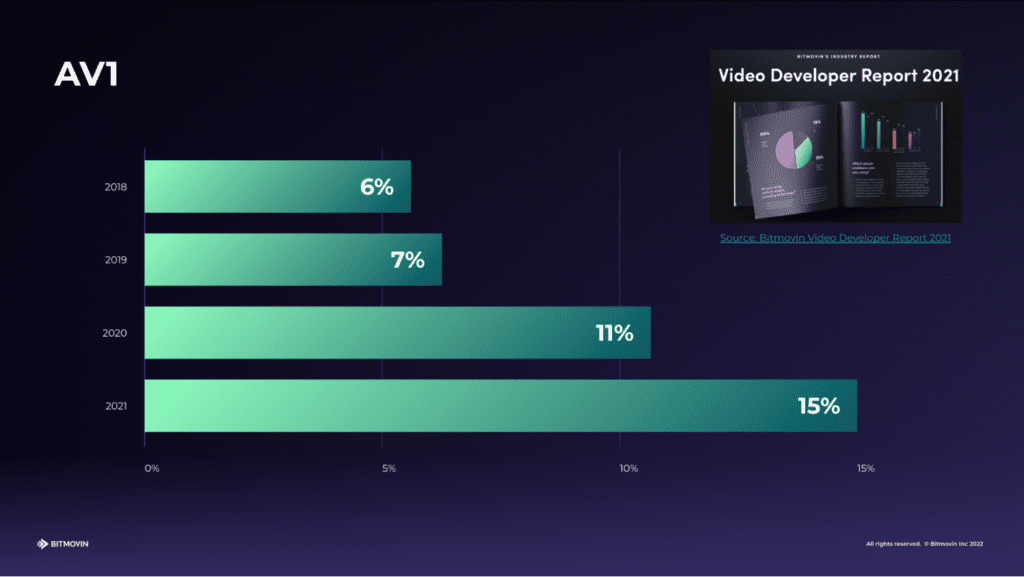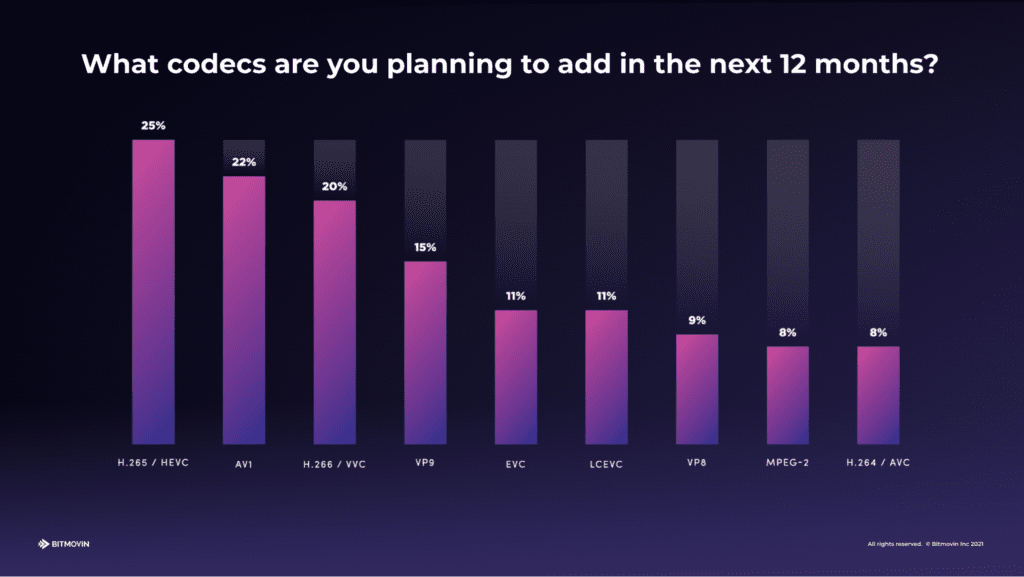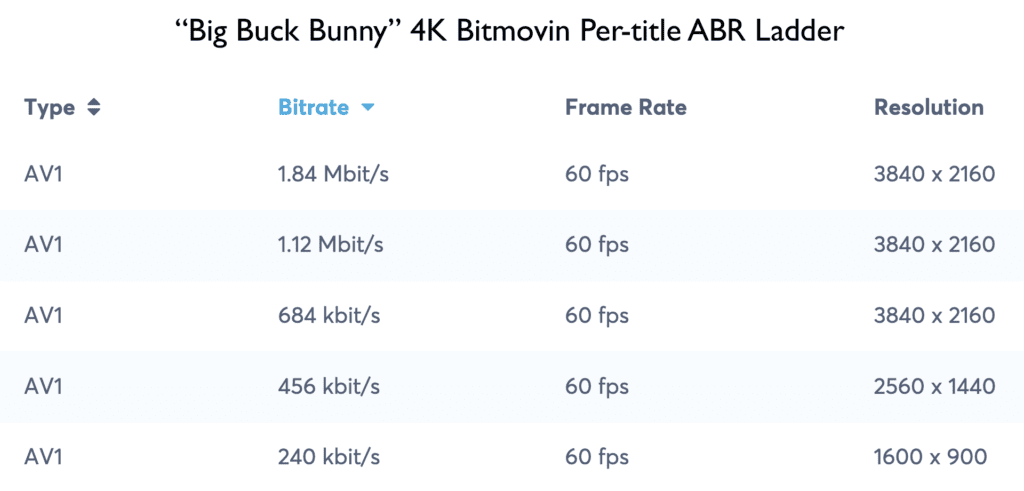What if I told you I could get you a sweet deal on a beautiful 1080p movie for less than 300 kbps? How about some stunning 4K under 700 kbps? Sounds too good to be true, right? Especially when you look at the recommended internet connection speeds from services like Netflix, YouTube, and Disney+:
SD: 700 kbps to 1.1 Mbps
1080p HD: 5 Mbps
4K UHD: 15 Mbps to 25 Mbps
Those are largely based on what’s needed to view SD/HD content encoded with AVC and 4K content encoded with VP9 or HEVC. Apple’s HLS spec has examples for AVC and HEVC that fall in line with those numbers and they are familiar ranges to anyone who has done any live streaming recently. So I’ll ask again, would you be interested in 1080p at 286 kbps or 4K at 684 kbps? It really is possible, right now, with Bitmovin Per-Title and 3-pass encoding together with the industry standard AV1 codec. Keep reading to see a few real examples and learn how to get started with your own AV1 encoding.
Leading the Way with AV1
Bitmovin has a long history with AV1, first making headlines in 2017 for debuting the world’s first AV1 live stream at that year’s NAB show, winning a Best of NAB award in the process. Later that fall, we partnered with Mozilla to create the first AV1 HTML5 playback demo in the Firefox browser. You can read more details about our history and progress with AV1 in this post, but recent highlights include adding smart presets and support for 3-pass and Per-Title encoding optimization. We’ve also developed 2 new patent-pending technologies around AV1 that we hope to share more details about soon!
While early adoption was limited by slower performance and minimal playback support, the data from our most recent Video Developer Report shows that AV1 may be at an inflection point, with 15% of respondents saying they were already using AV1 in 2021 and another 22% saying they planned on adding it to the mix in 2022.


Getting started with a new codec usually means beginning with some educated guesswork followed by a lot of experimentation that can end up being costly in terms of both time and resources. With AV1, we’re trying to help eliminate that phase altogether by pairing our Per-Title ABR ladder optimization together with 3-pass quality optimization in a SINGLE API CALL!!! Our Simple Encoding API combines Bitmovin’s market-leading quality together with DASH and HLS packaging, delivering the ideal bitrates to maximize QoE without any unnecessary overhead data. You choose the codec, provide the source file and destination and that’s it, no other configuration required. We also have a Postman Repository with some example templates, which is actually what I used to create the AV1 samples below. For workflows requiring additional configuration, AV1 and Per-Title are fully available and supported within our standard APIs and SDks.
4K Bitrates: YouTube VP9 vs Bitmovin AV1
YouTube’s use of AV1 and other codecs was covered thoroughly in an enlightening series of posts by Jan Ozer. The quick recap is that YouTube is using AV1 for the 4K versions of their popular videos, but VP9 for less-viewed 4K content, as I confirmed with my own uploads below. So while it would be nice and a more direct comparison if we had the results of YouTube’s AV1 transcoding, it’s still interesting to see the potential bitrate savings when jumping from VP9 to AV1. For the analysis, I used youtube-dl to download the 4K VP9 versions and MediaInfo to identify the bitrate.
Shot on iPhone 13 – “marina”
First let’s look at a short 4K (3840 x 2160) clip I shot on iPhone 13, “marina”. It’s a mostly static shot, with a few high motion/high detail regions. Bitmovin’s Per-Title optimization set the top 4K ladder rung at 1.37 Mbps. At the low end, the 240 kbps rendition was 1440p, meaning even on the slowest connections, viewers would still see better than full HD.
[bitmovin_player id=’225410′]

Youtube’s 4K version – VP9 @ ~22 Mbit/s
Big Buck Bunny
Next, let’s look at a more familiar example, everyone’s favorite animated short, Big Buck Bunny. On the top end, Bitmovin’s Per-Title AV1 delivers 4K under 2 Mbps. The bottom 240kbps rung is 1600 x 900, so even on over-shared wifi, your users would still be happily watching even better than 720p video. You can see the result here.

Youtube’s 4K version – VP9 @ ~12 Mbit/s
Tears of Steel
Last but not least, we have Tears of Steel, the cinematic short from the Blender Foundation that combines real footage and human actors with computer generated animation and effects. Again we see the top quality 4K variant under 2 Mbps and still have a full HD frame for the bottom 240 kbps version. Imagine being able to deliver at least HD video to all of your customers, regardless of connection speed. You can see the result here.

Youtube’s 4K version – VP9 @ ~12 Mbit/s
Get Started Now and Ride the AV1 Momentum
YouTube and Netflix have both been delivering AV1 to compatible Android devices since 2020 and last November, Netflix published a detailed post about using AV1 for 4K content, so while support for AV1 still lags a bit behind older codecs, there’s clearly already enough of a device footprint to make it worthwhile. Roku and Amazon’s newest “sticks” and the upcoming generation of Chromecasts are all <$100 options that give older TVs an AV1 upgrade and Intel, Qualcomm, and multiple SoC manufacturers have recently announced upcoming AV1 support, so the wave of capable devices will continue growing. While the actual numbers will vary based on your CDN and storage pricing, we’re seeing that for content with as few as 10K views, there is potential ROI in adding AV1 to your multi-codec strategy (AVC +HEVC).
Updating to AV1 means being able to deliver at least HD, in many cases 4K, over network connections that had been limited to Standard Def or compromised, blocky versions of your content. Improving and maintaining consistently higher quality with AV1 means happier customers and a larger potential market for HD and UHD upsell tiers, not to mention lower CDN and storage costs. For most streaming services, adding AV1 to their multi-codec strategy will be inevitable, the only question is how soon will they start reaping the benefits?
You can start seeing the benefits of AV1 + Per-Title and 3-Pass encoding today with our free trial, so sign up now and give it a shot! !
AV1 is the next generation video codec and it’s on track to deliver a 30% improvement over VP9 & HEVC – Learn More




